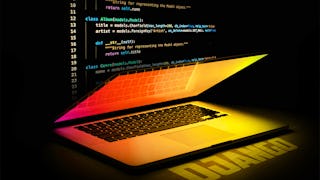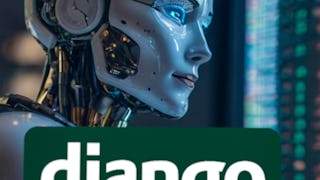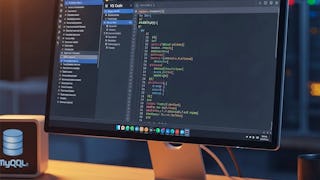Working with databases is a key skill for developers, especially those in Back-End, Full Stack, and DevOps roles. This course will teach you the fundamentals of relational databases and how to access them from your applications.

Enjoy unlimited growth with a year of Coursera Plus for $199 (regularly $399). Save now.

Django Application Development with SQL and Databases
This course is part of multiple programs.


Instructors: Yan Luo
61,345 already enrolled
Included with
(346 reviews)
Recommended experience
What you'll learn
Explain what a database is and create an entity relationship data model for a relational database.
Compose SQL queries to insert, select, update, and delete data in a database.
Use Django ORM to build object-oriented databases.
Integrate Bootstrap into your Django template and build interactive web pages.
Skills you'll gain
- Full-Stack Web Development
- Bootstrap (Front-End Framework)
- Model View Controller
- Authorization (Computing)
- Relational Databases
- Application Development
- Object-Relational Mapping
- Web Applications
- Databases
- Authentications
- Database Management
- Cloud Deployment
- Django (Web Framework)
- Database Design
- SQL
- Responsive Web Design
Details to know

Add to your LinkedIn profile
See how employees at top companies are mastering in-demand skills

Build your subject-matter expertise
- Learn new concepts from industry experts
- Gain a foundational understanding of a subject or tool
- Develop job-relevant skills with hands-on projects
- Earn a shareable career certificate from IBM

There are 5 modules in this course
What is data? As you start this course, you will be introduced to concepts fundamental to understanding data, databases, and database management systems. You will learn some basic SQL statements. Explore the structure, use cases, and limitations of relational databases. Learn key relational database concepts, including entities, attributes, entity-relationship data modeling, common data types, and primary key. You will learn about cloud database fundamentals and get hands-on experience creating a database instance on the cloud. At the end of the module, an optional lesson with more advanced SQL techniques will help you get the most out of your data.
What's included
13 videos8 readings5 assignments2 app items1 plugin
You’re aware that SQL is a powerful tool for working with databases. But in the modern application development environment, object-oriented programming is the most popular paradigm, and it is quite different from SQL. Is there a way to use Object-oriented programming to work with databases? Discover how Object-Relational Mapping (ORM) bridges the gap between object-oriented programming (OOP) and SQL and allows application developers to use OOP languages to work with databases without writing SQL code. Gain skills in using Django ORM, a popular ORM library for Python, to define models and fields so they can be mapped to database tables. Learn the steps for using Django ORM to convert your entity-relationship diagrams into Django models. Gain knowledge about using Django Model APIs to manipulate objects in databases without writing SQL queries. Explore the many useful methods Django Model provides to handle related objects.
What's included
6 videos2 readings2 assignments4 app items1 plugin
It’s time to build your skills by creating a Django web app. In this module, you’ll explore the Django Model- View- Template design pattern and learn how Django models, views, and templates work together to present data on a website. You’ll look at a typical Django development process, starting with building a Django project and creating and adding an app. Gain knowledge about the Django web app structure. Learn the steps to create Django models and views, add an HTML template, map the request URLs to your views, and design and build the UI. Next, use Django’s powerful admin site functionality to manage your site content. You’ll build an admin site and create an admin user. You’ll specify the model fields on the admin site and add UI features such as Search and Filter. Create a Django view to receive an HTTP request and send an HTTP response. Discover how to combine Django views and templates to present your data as dynamic web pages.
What's included
5 videos2 readings2 assignments3 app items1 plugin
Add to your Django skills by building a class-based view. Then, learn how to speed up development using Django’s generic-based views. Next, you’ll learn about authentication and authorization in Django. Create a User model to handle authentication and work with other models to handle authorization. Create web login, log out, and registration forms. Assign permissions to models and user groups. You’ll then move on to Bootstrap, a free and open-source web front-end framework. Learn how to quickly add Bootstrap to your Django template to build stylized and interactive web pages. Next, explore how to add static files to your apps. Learn how Django manages static files in development and deployment environments. Learn about the webserver interfaces supported by Django. And discover how Infrastructure as a Service and Platform as a Service offerings can streamline app deployment. Explore the benefits of deploying Django apps on IBM Cloud.
What's included
5 videos2 readings2 assignments3 app items
Welcome to the culmination of your learning journey in this Django course. In this module, you will apply your new skills and knowledge to improve applications in a practice project and a final project.
What's included
2 readings1 peer review3 app items2 plugins
Earn a career certificate
Add this credential to your LinkedIn profile, resume, or CV. Share it on social media and in your performance review.
Explore more from Cloud Computing
 Status: Free Trial
Status: Free TrialUniversity of Michigan
 Status: Free
Status: Free Status: Free Trial
Status: Free TrialMeta
 Status: Preview
Status: Preview
Why people choose Coursera for their career




Learner reviews
346 reviews
- 5 stars
73.69%
- 4 stars
15.02%
- 3 stars
5.20%
- 2 stars
3.75%
- 1 star
2.31%
Showing 3 of 346
Reviewed on Jul 5, 2022
this course made me fullstak developer Thanks foorfor all staff that doing this greetGreet job specially the labs which gives me an experiance to emplementing any site and webWeb application
Reviewed on Oct 17, 2022
This is a great and well laid out course to learn how to develop full stack app in django.
Reviewed on Aug 21, 2024
it is best course to learn SQL and Django application Development it is more informative to Learn it

Open new doors with Coursera Plus
Unlimited access to 10,000+ world-class courses, hands-on projects, and job-ready certificate programs - all included in your subscription
Advance your career with an online degree
Earn a degree from world-class universities - 100% online
Join over 3,400 global companies that choose Coursera for Business
Upskill your employees to excel in the digital economy
Frequently asked questions
To access the course materials, assignments and to earn a Certificate, you will need to purchase the Certificate experience when you enroll in a course. You can try a Free Trial instead, or apply for Financial Aid. The course may offer 'Full Course, No Certificate' instead. This option lets you see all course materials, submit required assessments, and get a final grade. This also means that you will not be able to purchase a Certificate experience.
When you enroll in the course, you get access to all of the courses in the Certificate, and you earn a certificate when you complete the work. Your electronic Certificate will be added to your Accomplishments page - from there, you can print your Certificate or add it to your LinkedIn profile.
More questions
Financial aid available,
¹ Some assignments in this course are AI-graded. For these assignments, your data will be used in accordance with Coursera's Privacy Notice.

